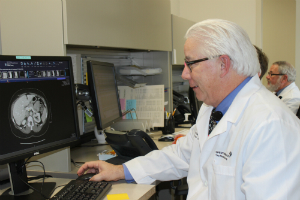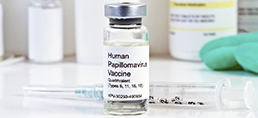
Chris Carey, an English teacher at Rockford High School, has a newfound appreciation for an old-fashioned Pap screening. It saved her life.
Now she reminds other women to get them regularly. It all started last winter when she was having issues and reluctantly went to the doctor for a checkup.
“I did a much better job of taking care of my children than taking care of myself. I didn’t have a Pap for years and years,” admitted Carey. “Then, after my last Pap, my doctor called with concerns, but I didn’t follow up on it as quickly as I could have.”
As it turned out, Carey was diagnosed with stage 1 cervical cancer. Her treatment included a radical hysterectomy, radiation and chemotherapy. Fortunately, after a difficult journey, she is now cancer-free.
“What could have been prevented or treated earlier was instead the cause of a world of hurt for my family and for me,” Carey said.
Cervical cancer, formerly a major cause of death, has become 60 percent less common in the past 60 years.
“Most of the decline in cervical cancer is due to Pap screening,” said Carey’s doctor, Leigh Seamon DO, MPH, a gynecologic oncologist of the Spectrum Health Cancer Center. “When we find abnormalities early, we can treat the precancerous lesions before they develop into true, invasive cancer.”
Cervical cancer begins in the cervix, which is at the end of the uterus. The cervix connects the uterus to the vagina.
About 12,000 women are expected to be diagnosed with cervical cancer in the United States this year, and more than 4,000 could die. Most of the victims will be women who haven’t had a Pap smear in the past five years, or maybe never had one.
Here’s what every woman should know about cervical cancer:
- Age matters: Women who are 21-29 should have a Pap screening every three years, and those 30-65 need to be tested every 5 years. Over 65? You won’t get the test because your risk is low. Note: If you don’t have health insurance, check with local women’s clinics for free or low-cost testing.
- When you have a Pap test, you will also be tested for human papillomavirus (HPV) if you are older than age 30. That’s because cervical cancer often begins with HPV, a common sexually transmitted infection. More than half of sexually active people will get HPV, but many don’t know they have it unless they develop genital warts, and warts are not caused by the same HPV strain as the one that causes cancer. The HPV strain that causes cancer does not cause warts.
- In the future, an HPV test may replace the Pap smear for primary screening after the age of 25. There are new recommendations coming out soon. There are also ongoing studies evaluating self-administered tests and this may one day be possible. Stay tuned!
- A new vaccine, called Gardasil, can prevent HPV. The Food and Drug Administration recommends the vaccine for girls and boys beginning as early as age 9, before they are sexually active.
- Using a condom can prevent the HPV virus from spreading. In fact, public safety campaigns about safe sex have helped to lower the rates of cervical cancer.
- At first, cervical cancer usually doesn’t have symptoms. When it advances, it may cause abnormal bleeding or discharge from the vagina or bleeding after intercourse.
- If you do get cervical cancer, your treatment will depend on your situation. It could include surgery, radiation and perhaps chemotherapy.
- Cervical cancer doesn’t necessarily mean no more babies. In some cases, a woman may lose her cervix to cancer, but may be able to keep her uterus.
Dr. Seamon is optimistic about the future—especially if parents make sure their children are vaccinated, which could lead to a decline in several cancers.
The challenge, she noted, is that not enough children are receiving the HPV vaccine.
“Moms and dads don’t want to think about the possibility of their pre-teen getting a sexually transmitted disease,” Dr. Seamon said.

 /a>
/a>
 /a>
/a>
 /a>
/a>